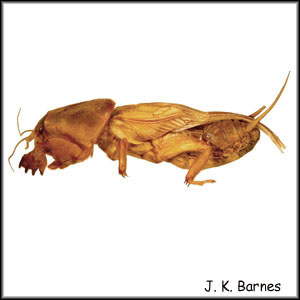Prairie mole cricket
Order: Orthoptera
Family: Gryllotalpidae
Genus and species: Gryllotalpa major Saussure

Mole crickets are stout, fuzzy, brown insects with short antennae and fossorial front legs reminiscent of those of moles. They burrow in moist soil, often near ponds and streams. They have an auditory organ, or tympanum, on the front tibia, and the males sing to attract mates. Only seven species of mole crickets occur in North America, six in the East and one in the West. Mole crickets of the genus Scapteriscus have been known to damage crops in the South Atlantic and Gulf Coast states.
The prairie mole cricket is the largest mole cricket in North America, growing to two inches or more in length. It is a rare insect native to the tall grass prairie in the south-central United States. As recently as the 1980s it was thought to be extinct, but populations are more common than previously thought. The U.S. Fish and Wildlife Service proposed the prairie mole cricket for threatened status in 1990. Subsequent distributional studies lead to the conclusion that the species was not entirely dependent of undisturbed native prairie, as originally thought, and the nomination for threatened status was withdrawn in 1992.
The former distribution was across the southwest portion of the tall grass prairies. However, because of habitat destruction the range has declined and now most populations are found in prairie remnants in northwest Arkansas, eastern Oklahoma, southeast Kansas, and southwest Missouri. Historic records extend to Illinois, Kentucky, Tennessee, and Mississippi. Most populations are occur in dry-mesic prairies and hardpan prairies. Ungrazed prairies with high plant diversity support the healthiest populations of prairie mole crickets. Populations are not supported in areas with saturated soils. Prairie mole crickets also are often found in grazed pastures, hayed prairies, and idle pasture areas with brushy invasion. This species does not survive plowing or heavy grazing, and it does not occur in crop fields, old fields, fescue pastures, or forests.
Food habits of the prairie mole cricket are essentially unknown. Crops of males collected during the breeding period were found to be empty. Female gut contents were thought to be masticated roots. Insect and spider parts have also been found in gut contents.
Prairie mole crickets are thought to require two to three years to mature. They spend the majority of that time underground, making the study of their life history difficult. Prairie mole crickets surface in the spring for courtship and reproduction. Males have fore wings modified for calling. Males call from late April through May. They start calling shortly after sunset and cease around dark. They can be heard up to about ¼ mile away. Males construct aggregated burrows in lek arenas from which they produce sexual advertisement calls. Their burrows have specialized resonance chambers at the entrances. Females are silent, but they can fly, whereas males are earthbound. Females migrate 3-5 miles to lay eggs elsewhere. It is thought that eggs are laid in June and July.
